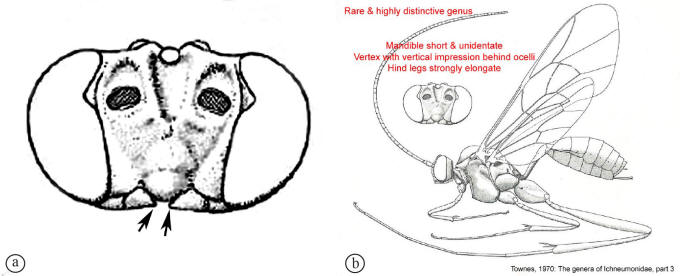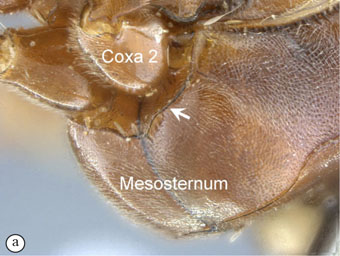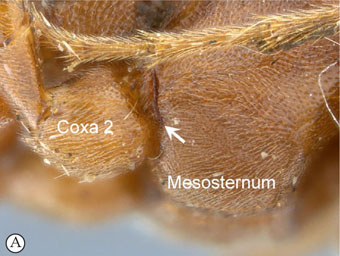
1. Mandible short and unidentate (a); vertex with vertical
impression behind ocelli; hind legs strongly elongate (b) …
Skiapus
Morley
- Mandible elongate and bidentate; vertex without
depression behind ocelli; hind legs moderately elongate (A) … 2

2. Posterior transverse carina of mesosternum more or
less complete (Fig. a) … 3

- Posterior transverse carina of mesosternum absent in
front of mid coxae (Fig. A) … 7
3. Distal margin of mid and hind trochantelli with a
sharp, decurved tooth on anterior side (Fig.a); forewing without
detached sclerites; mandibles twisted about 85° …
Stauropoctonus Brauns
- Distal margin of mid and hind trochantelli without a
sharp tooth, very rarely (in one species of Enicospilus) with a
sharp decurved tooth, but in such a case the forewing bears detached
sclerites (Fig. A); forewing otherwise with or without sclerites;
mandible from flat to twisted about 80° … 4
4. Occipital carina absent except for traces laterally ;
apices of mid and hind trochantelli flattened and projecting over
proximal ends of the femora (Fig. a) …
Lepiscelus Townes
- Occipital carina complete or narrowly obsolescent medio-dorsally;
apices of trochantelli usually simple, never overlapping ends of femora
… 5
5. Dorsal 0.4 of inner orbits paralleled by a sharp
raised carina on frons which is dorsally curved towards the lateral
ocellus (Fig. a) ; inner hind tibial spur cylindrical; posterior margin
of metanotum produced opposite propodeal spiracle (Fig. b) …
Dictyonotus Kriechbaumer
- Dorsal 0.4 of inner orbits without a carina (Fig. A);
inner hind tibial spur flattened internally; posterior margin of
metanotum not produced (Fig. B) … 6
6. Mandible somewhat twisted, conspicuously narrowed from
base to apex, or if (in one species) with mandible very weakly narrowed,
then with lower tooth the longer; mandibular teeth otherwise various,
the lower tooth longer than, equal to or shorter than the upper (Fig.
a); fore tibial spur without a trace of a membranous flange behind the
macrotrichial comb (Fig. b) …
Enicospilus Stephens
- Mandible not twisted, very weakly narrowed from base to
apex, with apical teeth sub equal (Fig. A); fore tibial spur either with
a vestigial membranous flange behind the macrotrichial comb, or with a
scar indicating the position flange would occupy if present (Fig, B) …
Dicamptus Szepligeti
7. Fore tibial spur with a membranous flange behind the
macrotrichial comb, and extending at least 0.4 of the length of the
tibial spur (Fig. a); forewing with 1m-cu usually with a
discernible ramellus … 8
- Fore tibial spur either without a membranous flange, or
with a minute flange behind macrotrichial comb that does not extend 0.1
of the length of the tibial spur (Fig. A); forewing without a ramellus …
9
8. Ramellus very long, reaching 0.7 of distance to Rs&M
(Fig. a); notaulus absent; fore tibial spur more than 2.5 times as
long as apical tibial breadth (Fig. b) …
Rhopalophion Seyrig
- Ramellus shorter, not reaching 0.5 of distance to Rs&M
(Fig, A); notaulus present on anterior 0.4 of mesoscutum; fore
tibial spur less than 2.0 times as long as apical tibial breadth (Fig .
B) …
Afrophion Gauld
9. Mandibles apically strongly narrowed, with upper tooth
distinctly the longer (Fig. a); pronotum mediodorsally with a raised
transverse keel (Fig. b) …
Orientospilus Morley
- Mandibles very weakly apically narrowed, subequally
bidentate (Fig. A); pronotum usually without a raised transverse keel
(Fig. B) … 10
10. Metasoma slender, tergite 2 in profile more than 3.5
times as long as deep posteriorly and with anterior margin of sternite 2
posterior to the spiracle of tergite 1 (Fig. a); clypeus, in profile ,
convex, with apical margin impressed …
Laticoleus Townes
- Metasoma rather stout, tergite 2 in profile less than
3.0 times as long as deep posteriorly and with anterior margin of
sternite 2 anterior to spiracle of tergite 1 (Fig. A); clypeus, in
profile, flat, apical margin flat to out-turned …
Euryophion Cameron
|